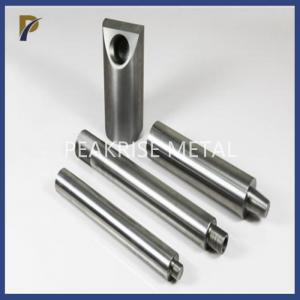
Add to Cart
Application Of Molybdenum Electrode In Glass Furnace
1. Description Of Molybdenum Electrode In Glass Furnace:
Molybdenum electrodes are currently used in many all-electric glass furnaces and flame-boost glass furnaces.
Molybdenum electrodes are commonly used electrodes for melting soda-lime glass and high borosilicate glass. They have high operating temperature and surface current intensity, which can even be as high as 2000 °C.
Proper use of molybdenum electrodes is critical for kiln design and manufacturing engineers. The value of electrodes is often only about 10-15% of the value of the furnace, but for glass furnaces with different designs of different glasses, the correct application of electrodes is the determining factor for the success of the furnace.
2. Size Of Molybdenum Electrode In Glass Furnace:
| Diameter.(mm) | Tolerance | Length (mm) | Tolerance |
| 16-20 | +1.0 | 300-1500 | >+2 |
| 20-30 | +1.5 | 250-1500 | +2 |
| 30-45 | +1.5 | 200-1500 | +2 |
| 45-60 | +2.0 | 250-1300 | +3 |
| 60-100 | +3.0 | 250-800 | +3 |


3. Effects of Molybdenum Electrode Impurities and Density on Glass Quality:
The ratio of impurity content in molybdenum electrode and the forging density and density uniformity of molybdenum electrode are the most important indicators of molybdenum electrode quality.
The molybdenum electrode with less impurities is a decisive factor for the chromatic transparency of the glass. Metals or metal compounds such as iron, nickel and cobalt in molybdenum electrodes are the main leaders of glass coloring. The iron content exceeds 150PPM. The glass will have a clear green feeling. If it is kept warm for 48 hours, the whole pool will be full of green glass.
The effect of iron and nickel in impurities on the life of molybdenum electrodes is fatal. Iron and nickel exist in molybdenum metal as single-phase or polymetallic compound solid solutions and the melting points of iron and nickel metal compounds are much lower than those of molybdenum and lower than those of glass. These impurities are first melted into the molten glass to drive the premature erosion of the molybdenum electrode by the glass. Therefore, furnaces using low-grade molybdenum electrodes often appear gray and poor transparency only a few months after the furnace is put into production. The continuous grey line grey bubbles were found to be causing the kiln to fail. Similarly, the presence of iron and nickel in the molybdenum electrode is a major reason for the easy fracture of the molybdenum electrode.
The forged density of molybdenum electrodes is an important factor in service life and the generation of micro-bubbles in the glass.
4. Package of Molybdenum electrode rod for glass furnace:


Do you want to know more about our products?
